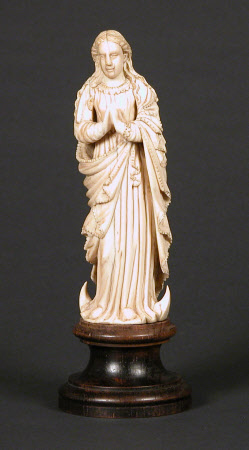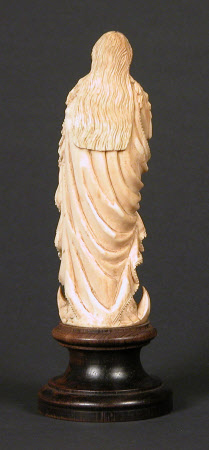The Virgin of the Immaculate Conception
Indo-Portuguese
Category
Art / Sculpture
Date
circa 1650
Materials
Ivory on wooden socle
Measurements
217 x 88 x 88 mm
Place of origin
Goa
Order this imageCollection
Bateman's, East Sussex
NT 761010
Summary
Ivory on turned wood socle, The Virgin of the Immaculate Conception, Indo-Portuguese, probably Goan or Sri Lankan, c.1650. An ivory statuette of the Virgin of the Immaculate Conception, showing the Virgin in prayer, standing on a crescent moon.
Full description
In Marian iconography the Virgin with a crescent moon is identified with the Woman of the Apocalypse, described in the Book of Revelation as a woman with 'the moon under her feet, and on her head a crown of twelve stars'. The statuette was probably produced in the middle of the 17th century in Goa or Sri Lanka, then Portuguese colonies. To cater to colonial tastes and to resident missionary Orders, Goan and Sri Lankan artists used often imported Mozambique ivory and adopted baroque Christian subject matter to form a contemporary Indo-Portuguese style of sculpture. Ivories such as this were presented as diplomatic gifts to Western rulers or used in the dissemination of Christian imagery. They were also exported to Europe, for display in religious institutions and private collections. For similar examples see Victoria and Albert Museum, London, nos. A.60-1949 and A.35-1940. Alice Rylance-Watson January 2019
Provenance
Bequeathed to The National Trust in 1939 by Caroline Kipling, Rudyard Kipling's widow.
Credit line
Bateman’s, The Rudyard Kipling Collection (The National Trust)
Makers and roles
Indo-Portuguese, sculptor
References
Trusted 2013: Marjorie Trusted, Baroque & Later Ivories, Victoria & Albert Museum, London, 2013, p.365


